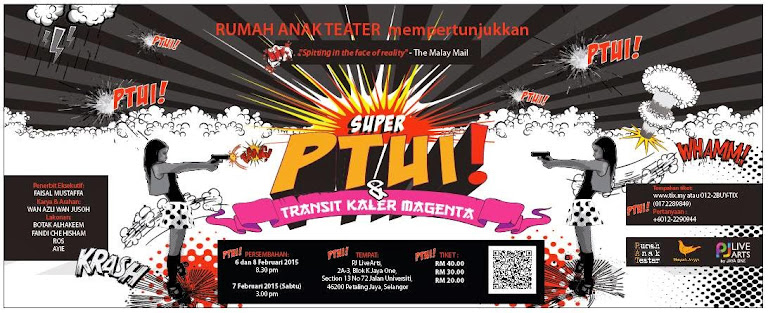by JOSEPH GONZALES
 A rivetting scene with Ameerul Ariffin and Intan Diyana (left) in Khairulnazwan Rodzy’s Pokok Kelapa Sayang
A rivetting scene with Ameerul Ariffin and Intan Diyana (left) in Khairulnazwan Rodzy’s Pokok Kelapa Sayang A scene from Fared Ayam’s Stabil. The characters needed more fleshing out
A scene from Fared Ayam’s Stabil. The characters needed more fleshing out
THE debut production of Rumah Anak Teater entitled, Teater Kompilasi Vol I, was precisely the breath of fresh air the Kuala Lumpur theatre scene so desperately needs.
Several young theatre graduates of the Diploma Programme at the National Arts Culture and Heritage Academy (Aswara or Akademi Seni Budaya dan Warisan Kebangsaan) have joined forces to create the theatre collective under the mentorship of Shahili Abdan, better known as Namron, through his Komuniti Kental Project. ‘Kental’ means strength and according to the artistic director’s notes, it is this strength of spirit that he is trying to nurture to face the challenges of life as a professional theatre practitioner in Malaysia. In Namron, the fledgling group Rumah Anak Teater has found an artistic mentor and an inspiration much like what the late Krishen Jit was to Namron in the late 90s. Through collaborations with Instant Café’s Kurang Manis and Breaking Ji Po Ka Ci Pecah, productions at the KLpac namely AirCon, and other works by new directors such as Megat Sharizal, these young talents are garnering a following that is coming to expect on-the-edge works, intelligent scripts, good acting, and alternative interpretations. The six sold-out performances which ran Jan 28-Feb 1, at Stor Theatre Dewan Bahasa dan Pustaka that seats about 100 people, were testimony to that. The last time that this zeitgeist occurred in Malay theatre was when the likes of Nordin Hassan, late Syed Alwi, Hatta Azad Khan, Zakaria Ariffin and other ‘‘angry young men’’ and undergraduates of Universiti Sains Malaysia staged works in the 80s. Kompilasi Vol. I enthralled. Zahiril Adzim’s Teruk, Khairulnazwan Rodzy’s Pokok Kelapa Sayang, Khairilridwan’s Tambat Kaki, Fared Ayam’s Stabil were the four short works written and directed by the young men. Each play was between 20-30 minutes long, based on the theme of power. They presented the plays in the spirit of Jerzy Grotowski’s poor theatre, devoid of excessive costuming or make-up, sets or props.In Kompilasi, the stable of acting talent comprised seven performers including the directors themselves with Ameerul Affendi, Sherry and Intan Diyana. They told the stories with conviction, honesty and a sense of realism that I enjoyed in the intimate theatre setting. The individual interpretations were evidence of their own particular journeys and what was uppermost in their minds – ‘‘power’’ in love and politics.A sense of despair was palpable in all the works, each with its own tragic ending. It appears that as young Malaysians or Malaysian artistes, they were all aware of the futility of their opinions but ecstatic in the avenue to express themselves. This joie de vivre and in-your-face attitude resonated with the audience. Of the plays, I thought that Pokok Kelapa Sayang was the most convincing, allowing for sufficient character development in the short span of time, building clear relationships and leading to a climax with a clever twist at the end. One could feel the tension building, the simmering unhappiness and eventual obsession that ends in madness leading to murder. The character, Hasyim Tua, appears to have an unnatural attachment to the coconut tree and slowly the audience is drawn into the plot. Khairilridzuan was the only one who chose a blatantly political theme in his interpretation of power, mocking the didactic Pak Tam as a symbol of what he clearly sees as a diseased political climate in Malaysia and perhaps, many other countries. Preaching fire and brimstone, and unashamedly misusing the name of religion to strike fear into the hearts of the constituents to simply buy their vote and tambat kaki or having their feet tied, metaphorically. The reactions of the citizens are voiced through three young glue-sniffing men. Bob, in his glazed state of mind, is surprisingly sharp in his analysis of situation and able to see through the hypocrisy, while the irony is provided by the other two characters who are more trusting and innocent.Teruk tells of a love between a jobless young man and a beautiful successful woman that gradually descends into hopelessness, while the character in Stabil is unable to deal with a breakup of a relationship that is only hinted at. These two stories need to be a little more thought through and the characters more fleshed out. The audience needs to be convinced of their drastic action in order to sympathise with their plight. But there is great potential for development since the stories deal with very contemporary issues of the changing role of women and the conventional perceptions of success or respect that is prevalent in today’s society.The acting skills of the RAT ensemble were of a consistently high standard throughout the four plays and at times, achieved brilliance. I felt Ameerul Ariffin in Pokok was riveting. This undergraduate at Universiti Malaya has sincerity, charm and a believable quality of the boy-next-door. The challenge in repertory acting is to make these different characters in different plays believable and this requires extensive and intensive practice. The performers need to observe and give the various characters individual physicality. For instance, no two people have the same smile, and I trust with greater experience this can be honed to a higher level. The scenography by Yusman Mokhtar was clever in its simplicity. This young man deserves kudos for intelligently using white transparent curtains to create different spaces and times. It proved to be effective and practical combined with the lighting design that gave the illusion of space in the extremely confined performance area. This he overcame with the right use of video projection at the right times. Another interesting addition to the evening’s presentation was the element of live music performed ably by guitarist Indra Za’aba, an Aswara final-year music student. It gave a sense and slice of Malaysian life and the buskers at the ‘mamak’ stalls. Being a fan of The Police, I was thrilled that its classic Roxanne was used! The only minor criticisms that I have is of the use of the chair (that was on the poster as well) that seemed to be a little contrived and sent mixed signals to the audience. Whether it was meant to be a symbol of power as often is in theatre or merely a prop that could thread these separate stories together was unclear. I found it also disturbing that so many characters in the various plays were smoking, which is potentially unhealthy in a small venue. Another production note was that there should have been a warning at the entrance that strobe lighting would be used during the play. This is standard practice in theatre these days. Audiences love the magic of mega-productions with lavish sets and costumes, innumerable performers onstage, which makes for entertaining theatre. Miss Saigon, Cats and Puteri Gunung Ledang proves this beyond doubt. But nothing moves me more than small, intense shows that make a sincere effort to challenge the audience while still not failing to entertain.
sumber : NST



